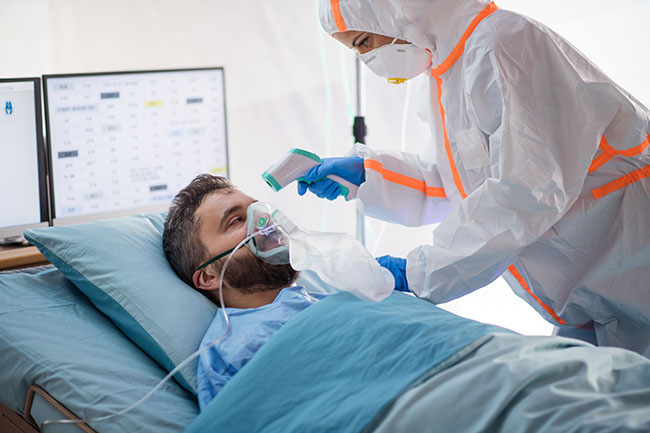
Protecting the front line needs to be priority No. 1
April 15, 2020
By
Nancy Johnson
Safety experts can lead teams to quickly train and drill workers

Proper equipment and training are of paramount importance, if Canada is to get through the current COVID-19 pandemic, writes Nancy Johnson. (Adobe Stock)
As the COVID-19 pandemic endures, Ontario’s premier has expressed his intention to put “an iron ring of protection around our seniors.”
Governments, employers and workers need to work together to build that ring in every long-term care and seniors’ residence in this country — now.
Together, we need to be nimble and quickly apply lessons from SARS, H1N1, Ebola and other COVID-struck countries.
In true Canadian fashion, the best way forward is to work as a team to “figure out where the puck is going” and be ready for it.
Almost two decades ago, Justice Archie Campbell warned that the No. 1 lesson for the next inevitable outbreak is the precautionary principle — when not all is yet known, err on the side of safety.
When health-care workers are not safe, neither are the rest of us, he said.
Keep health-care workers healthy
Ontario’s pandemic plan after Ebola put health-care worker safety front of mind.
Knowing it would not be a matter of if — but when — we would see the next outbreak, it embraced the importance of ensuring safe workplaces throughout the health system to protect health-care workers from contracting disease, which would not only take them out of service, but also increase the risk of spread as they themselves became unwitting vectors transmitting infection to patients and bringing it home to families.
That plan recognized the need to collaborate, to respect the need for workplace safety experts to lead broad and local responses and to regard workplace safety committees as valuable resources to be consulted regularly in development of precautions, outbreak monitoring and adjustments along the way.
Trust in your experts
Given past lessons, the COVID experiences from other jurisdictions and our own current pandemic troubles, it is imperative that:
- National, provincial, regional and workplace safety expert teams lead infection control personnel in devising and implementing workplace measures. (This approach would have the added benefit of freeing public health experts to focus their energy on testing, contact tracing and public-health issues.)
- These teams work quickly to prepare advice, guidance and support to workplaces to prevent COVID exposures where possible and safely deal with them where necessary.
In addition, a risk-assessment approach should be used at each level to identify and implement preventive and protective measures based on sound occupational health and safety principles including:
- the precautionary principle
- the need to engage the workplace internal responsibility system (IRS) and joint safety committees or health and safety representatives where they exist
- the hierarchy of controls which calls for elimination of the hazard where possible, and if not possible, implementing engineering controls (such as ventilation adjustments and physical barriers like Plexiglas), administrative controls (such as restriction of access and infection control procedures) and appropriate PPE.
Training is critical
Of primary importance in a workplace safety approach is the fundamental and absolute need to properly equip workers and educate, train and drill them until — to borrow an ironically apt phrase from a controversial American industrialist — “safety is regarded as a fundamental value, a pre-condition, as automatic as breathing.”
Safety experts can lead infection control teams to quickly train and drill workers in hospitals, long-term care homes and retirement residences. Ministries of Labour and Health teams can then monitor implementation and effectiveness.
It has been widely reported that after Wuhan’s initial failings with their outbreak, they re-grouped, implemented airborne precautions, cohorting, isolation and rigorous training in safe donning, doffing and wearing of PPE.
This is believed to have greatly contributed to their ultimate success.
Workers need proper PPE
As Justice Campbell said: “It’s not (just) about the mask.” It is about a comprehensive health and safety approach to this challenge, underpinned by the precautionary principle.
Even if the mounting evidence that COVID is airborne is not yet accepted by all, we need to invoke the precautionary principle to protect the airways of workers who — on a risk-assessment basis — are determined to potentially be in exposure range of a suspect or confirmed COVID patient.
And those involved in high-risk respiratory procedures should be equipped with even higher respiratory protection. Industrial workers do not enter dangerous confined spaces with only N95s — commonly known in industry as “dust masks.” So why do governments think dust masks are sufficient for health workers in high-risk procedures?
Finally, one of the key lessons of these past few weeks has been a broader vision of what constitutes essential workers.
This virus doesn’t know or care what threshold it is crossing — whether it be a hospital’s intensive care unit, a long-term care room or a grocery store. And it doesn’t know or care if its potential victim is wearing a stethoscope, carrying a clipboard or using a mop.
We now know that all essential workers deserve equal regard and appropriate protection from this virus. If they are not safe, neither are we.
The late Dr. Maya Angelou said: “Do the best you can until you know better. Then when you know better, do better.”
After weeks of this, we now all know better. It’s time to work together to do better.
Now retired, Nancy Johnson is a former occupational health and safety specialist with the Ontario Nurses’ Association and current co-chair of the Northeast Family Council Network in Sudbury, Ont.